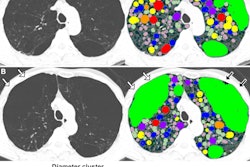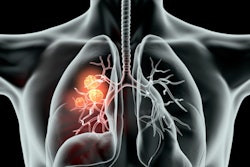The spatial distribution, or “compactness,” of CT emphysema voxels can predict emphysema progression in individuals with and without chronic obstructive pulmonary disease (COPD), researchers have reported.
A team led by Sukhraj Virdee, PhD, of Toronto Metropolitan University in Canada found that using "CT normalized join-count" (NJC) data quantifies the voxel compactness of emphysema images, suggesting a "predictive capability for emphysema progression as quantified by CT lung density and decline in lung function and gas transfer in individuals with chronic obstructive pulmonary disease." The study results were published July 16 in Radiology.
"[The] CT normalized join-count (NJC) measurement, which assesses the 'compactness' of CT emphysema, is more closely related to lung diffusion capacity and visually assessed emphysema than traditional emphysema measurements," the group explained. "Based on these findings, a denser spatial arrangement of emphysema could lead to faster disease progression due to greater exposure of surrounding tissues to biomechanical forces."
Emphysema found on CT imaging has been acknowledged as a potential indicator of worsening disease in patients with COPD, but it's unclear whether other factors – such as the spatial compactness of emphysema on a CT exam – could also predict emphysema progression, the group explained. To explore the question, the group conducted a study using data from the Canadian Cohort Obstructive Lung Disease (CanCOLD) study, assessing normalized join-count measurements and lung density changes from 524 individuals with and without COPD at baseline imaging and at a three-year follow-up. The team defined emphysema progression as an annual lung density change of less than half a standard deviation below the mean of the participants without COPD and no smoking history. Of the study cohort, 36% had COPD.
The team found that CT normalized join-count was linked to the following measures that indicated emphysema progression:
- Annualized change in lung density (p < 0.001);
- Forced expiratory volume in first second of expiration (p = 0.02)
- Diffusing capacity of lung for carbon monoxide (p = 0.01)
It also reported that CT normalized join-count predicted emphysema progression with an odds ratio of 2.24 (p < 0.001).
The study findings show promise for helping clinicians track patients' emphysema disease progression, the authors concluded.
"The NJC measurement may be a useful imaging biomarker for identifying individuals who are at risk for accelerated progression of emphysema," they wrote. "Future research should validate these findings across a broader spectrum of chronic obstructive pulmonary disease severity and explore the integration of NJC measurements into longitudinal disease management strategies."
The complete study can be found here.




















